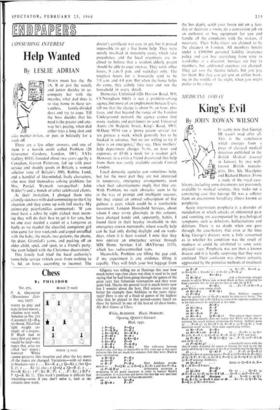Chess
By PHILIDOR
P. A. ORLIMONT (Muenchener Zeit- ung, 1927) WHITE to play and mate in four moves ; solution next week. Solution to No. 27o (Caresmel): QŌĆöB 4, no threat. Excellent light weight ex- ample of a mutate. If Black had to move first any move would be fatalŌĆöthe mates that arise are hosirever White cannot preserve this situation and after the key move all the mates arc changed. VariationsŌĆöwith set mates in bracketsŌĆöare 1 . . . KtŌĆöK 4 ; 2 QŌĆöKt 5 (Set QŌĆö K 2). 1 . . Kt (5) else ; 2 QŌĆöQ 4 (QŌĆöB 3). I . . . KtŌĆöK Kt 3 ; PxKt(RxP). ...PxKt; 2 BPx P (QŌĆöK Kt 7). This week's problem is difficult but rewardingŌĆöeven if you don't solve it, look at the solution next week.
Gligoric was telling me at Hastings this year how much better top-class chess was than it used to be and saying that he had been going through the games of the great 1911 San Sebastian tournament and they were quite bad. Maybe the general level is much better now but I wonder about the best. Did anyone ever play better for example than Alekhine in the years 1929- 1932? Here is one of a flood of games of the highest class that he played in this periodŌĆönotes based on those by himself in one of the best of all chess books, My Best Games of Chess.
White, ALEXHINE. Black, MAROCZY. Opening, QUEEN'S GAMBIT. Bled, 1931.
PŌĆöQ 4 PŌĆöQ 4 PŌĆöQ B 4 PŌĆöK_3
3 Kt--Q B 3 KtŌĆöK B 3 4 BŌĆöB1 5 13ŌĆöK 2 3 PŌĆöK 3 8┬▒13-Q2
6 KtŌĆöB 3
7 RŌĆöB PŌĆöK R 3 8 BŌĆöR 4 PŌĆöB 3 One difference between modern play and that of twenty-five to fifty years ago is that quiet defences like this are much less common then they were; Black is more adventurous.
9 B--Q 3 PŌĆöR 3 zo 0-0 P x P
zz B x P PŌĆöB 4 Here Alekhine recom- mends txŌĆö . PŌĆöQ Kt 4; 12 13-0 3, BŌĆöKt 2 and then PŌĆöB 4. R 12 PŌĆöQ 4! . . . deliberately accepting' a weakening of his pawn structure in order to hamper Black's development. It is decisions and moves like this that win (and lose) ;games and make the later brilliancies possible. QŌĆö x D 4 z3 2 P PI r4 P >r P . . . 14 Kt x P?, KtŌĆöK 4; 15 BŌĆöQ Kt 3, KtŌĆöKr 3!; si5 BŌĆöKt 3, PŌĆöK 4! 14ŌĆó_.: -,ŌĆ× . KtŌĆöKt 3 15 BŌĆöQ 3/ŌĆó ŌĆó ŌĆó now a fascinating struggle ensues in which White tries to keep Black so busy defending his king's position that he will get no time to take the Q R P. BŌĆöQ 2 15 ... Kt x P; t6 KtŌĆöK 4 gives White a very strong attack. z6 KtŌĆöK3 K RŌĆöQ r 17 PŌĆöB 4 . . . Here Alekhine suggests that the quieter line 17 QŌĆöB 3 might be objectively better. The move he plays (like 12 PŌĆöQ R 4) is a sign of the supreme confidence in his own powers he displayed at this time.
11ŌĆöK 1 18 KtŌĆöKt 4 R Y P zg B x Kt B Y B zo Ktx 13 ch Px Kt
az KtŌĆöK 4 Q RŌĆöQ r? This natural move losesŌĆö Black (very naturally) does not realise that White will be able to continue his attack without protecting the bishop. _Alekhine gives as . . . PŌĆöB 4!; 22 KtŌĆöB 6 ch, KŌĆöB I; 23 PŌĆöQ Kt 3 'with uncertain result' as best. Now some superb play follows.
az Kt x P ch KŌĆöD z
.23 KtŌĆöR 7 Oil KŌĆöK a 23 . . . KŌĆöKt r; 24 QŌĆö Kt 4 ch, KŌĆöR 1; 25 QŌĆöR 4!, R xB; 26 Q x R P! and wins. 24 P-831 i? (Q 1)- - Q 3 24...RxB;25PŌĆöB6cb and 26 QxRc.h. a3 PŌĆöQ Kg 41! . . . a wonderful move with the idea of either diverting the queen or forcing the rook to cut the queen off from Q 7 (because 25 QŌĆöR 5? would be met by tp70 Q x Kt P 25 . . . R x P; 26 51 (threat PŌĆöB 6 ch winning queen), PŌĆöK 4; 27 PŌĆöB 6 ch, ŌĆöQ a; 28 Q x R P!, R x B; 29 QŌĆöB 8, RŌĆöQ 2; 30 RŌĆöQ B 51, Q xP; 31 R xP winning (Alekhine). 26 let7-K 31 . . . threat 27 QŌĆöB 6 di, KŌĆö Q a; 28 KI....-B 8 mate. a6 . _ Q . . KtŌĆöQ a a7 -R 8 R X B Or 27 . . . QŌĆöKt 3; 28 PŌĆöR 51, fix P; a 23 RŌĆöB 8 (28 ... QŌĆöR 2; 29 PŌĆö 6 ch). 28 PŌĆöEI chl Resigns ., . kŌĆöQ i ; al Q x BAK xQ; 3o R-13 2 mate Or at ... Kt XP; 29 QX"..t dl. K a; 3o KtŌĆöB 8 mate.


































 Previous page
Previous page